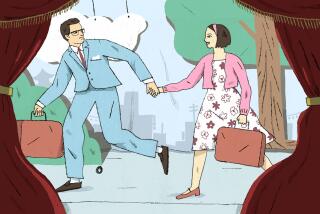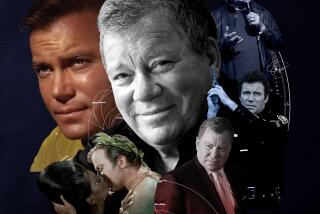Not just Spock: Leonard Nimoy’s arts trek covered many galaxies
“Leonard Nimoy carried conviction,” is the first sentence ever written in the Los Angeles Times, 59 years ago, about the man-who-would-be-Spock. He was playing a supporting role in a now-forgotten play called “Life Is But a Dream” at a now-defunct L.A. venue, the Civic Playhouse.
Nimoy, who died Friday at 83 at his home in Bel-Air, carried his convictions far in many varied arts endeavors that were light years distant from the screen roles for which he’ll be indelibly remembered by millions.
------------
For the Record
May 29, 6:23 p.m.: This post says the Los Angeles Times first wrote about Leonard Nimoy in 1956. The Times wrote about him as early as 1952.
------------
As a stage actor, not yet famous, he delved into the edgy, dark theater of Jean Genet, performing in the 1960 L.A. premiere of the French playwright’s explosive prison drama, “Deathwatch.” The venue was a Hollywood coffee house.
In 1962, Nimoy secured the film rights to the play along with its producer-director, TV star Vic Morrow. The movie premiered in the spring of 1966 with Morrow directing Nimoy as a petty thief who turns murderous after being locked in a cell with Paul Mazursky and Michael Forest.
The Times’ movie review -- published six months before “Star Trek” went on the air -- said that “Nimoy … has conceived this character carefully and completely,” although the film as a whole was “worthwhile but not satisfying.”
As a playwright, Nimoy has had a lasting legacy as the writer of a one-man show, “Vincent,” the story of Vincent Van Gogh as told by his brother, Theo.
Nimoy launched the play by giving 150 performances during the early 1980s in a 35-city tour that followed the play’s premiere at the Guthrie Theater in Minneapolis. Other actors have taken things from there, keeping the script alive in periodic revivals.
The next one is April 17-19 at the Little Theater at UCLA’s Macgowan Hall, starring Jean-Michel Richaud, part of the CAP-UCLA performance series. As a prelude, Nimoy had been scheduled to join CAP-UCLA artistic director Kristy Edmunds for an April 10 public conversation at Royce Hall, entitled “Mapping an Artist’s Journey.”
As a photographer -- his main creative pursuit from the early 2000s onward -- Nimoy often celebrated the female form, usually naked, including a series called “The Full Body Project” that focused on extremely corpulent nude women. His black-and-white group portraits were full of dancing movement and made the point that obesity need not be a bar to beauty, exuberance and grace.
In 2010, the Massachusetts Museum of Contemporary Art in North Adams organized a show called “Leonard Nimoy: Secret Selves,” in which the photographer, who grew up in Boston, asked for volunteers willing to be interviewed about some of their innermost fantasies or hidden conceptions about themselves.
He then dressed and posed some of the interviewees as that “secret self” and captured the images in life-size prints. The show, which had a sneak preview at the Santa Monica Museum of Art in 2009, also included a video of the interviews.
“[Nimoy’s] work is very sensual, but the other thing about Leonard is that he was always interested in the back story, why something was what it was,” recalled Louis Stern, whose Louis Stern Fine Arts gallery in West Hollywood represented the actor-turned-photographic artist. “Leonard was a very engaging man who could talk about almost anything.”
As art collectors and donors to museums, Nimoy and his wife, Susan Bay Nimoy, have had an ongoing impact on the contemporary art scene.
Their cultural gifts included $100,000 to L.A.’s Museum of Contemporary Art (MOCA) in 1998 to buy a photographic series by Nan Goldin, and $1 million in the early 2000s toward the renovation of the Griffith Park Observatory. A 190-seat theater at the observatory for screenings and lectures is called the Leonard Nimoy Event Horizon.
The couple also helped fund L.A. artist Mark Bradford’s first retrospective exhibition, in 2010 at the Wexner Center for the Arts in Colombus, Ohio. They sponsor one of the $50,000 annual fellowships that Los Angeles-based United States Artists awards to artists who are seen as doing innovative work in a wide range of literary, performing and visual disciplines.
“Leonard and Susan really understood how difficult it was for artists, so they lent their support,” Stern said.
Susan Bay Nimoy served on MOCA’s board for about eight years until 2006, when she resigned in frustration over the steady overspending that led two years later to the museum’s near collapse. She’s now on an advisory board of the Hammer Museum.
“Those of us who protested were ignored, and we left,” she would later say of the run of budget deficits that eventually crippled the museum – and prompted the California Attorney General’s office to chastise it for the overspending and require it to replenish the endowment that the museum had improperly tapped to meet operating expenses.
The Nimoys also supported Jewish music. In 2002, Nimoy served as narrator for the Los Angeles Jewish Symphony’s performance of “Cantata of the Bitter Herbs,” a rarely performed 1937 piece in which composer Ernest Toch linked the suffering of the Jews in ancient Egypt to the suffering – just a prelude, it turned out – that they were enduring in Nazi Germany of the 1930s.
It wasn’t all creative triumph for Nimoy. In 1996 he directed the world premiere of “The Apple Doesn’t Fall…” in which playwright Trish Vradenburg tried to maintain a streak of humor while telling the story of a daughter trying to find a way to reverse her mother’s slide into Alzheimer’s-induced dementia.
After getting a tepid review in The Times during its initial run at the Tiffany Theatre in Los Angeles, it moved straight to Broadway. Massacred by the New York critics, it closed immediately after opening night.
Nimoy’s other Broadway credits include playing an escaped prisoner of war in a 1973 revival of “Full Circle,” a play by Erich Maria Remarque set in 1945 Berlin, in the waning days of the Third Reich. In 1977, toward the end of the three-year initial Broadway run of “Equus,’ Nimoy stepped into the role of the psychologist that previously had been handled by Anthony Hopkins, Richard Burton and Tony Perkins.
Follow boehmm of the LA Times for arts news and features
More to Read
The biggest entertainment stories
Get our big stories about Hollywood, film, television, music, arts, culture and more right in your inbox as soon as they publish.
You may occasionally receive promotional content from the Los Angeles Times.







